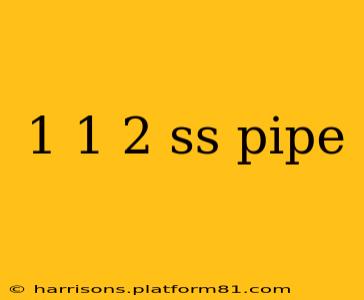Schedule 40 1 1/2" stainless steel (SS) pipe is a versatile material used across numerous industries. This guide delves into its properties, applications, and considerations for selection. We'll explore common questions surrounding this type of pipe, ensuring you have a complete understanding before making any purchasing decisions.
What is 1 1/2" SS Pipe Used For?
1 1/2" SS pipe finds applications in diverse sectors due to its inherent strength, corrosion resistance, and hygiene properties. Common uses include:
- Chemical processing: Handling corrosive chemicals and fluids requires materials that can withstand harsh environments. Stainless steel's resistance to degradation makes it ideal.
- Food and beverage industry: Maintaining sanitary conditions is paramount. Stainless steel's non-reactive nature prevents contamination and simplifies cleaning.
- Pharmaceutical manufacturing: Similar to the food industry, stringent hygiene standards necessitate the use of materials like stainless steel piping.
- HVAC systems: In some high-end or specialized applications, stainless steel's durability and corrosion resistance may be preferred over other materials.
- Industrial applications: General-purpose industrial uses where strength and corrosion resistance are crucial.
What are the Different Grades of 1 1/2" Stainless Steel Pipe?
The grade of stainless steel significantly impacts its properties and suitability for specific applications. Common grades include:
- 304 (18/8): This is a widely used austenitic stainless steel, offering excellent corrosion resistance and formability. It's a good all-around choice for many applications.
- 316 (18/10): This grade contains molybdenum, providing enhanced resistance to chloride corrosion, making it suitable for marine environments or applications involving saltwater.
- 410: A martensitic stainless steel, known for its high strength and hardness, but offering slightly lower corrosion resistance than 304 or 316.
What is the Difference Between Schedule 40 and Schedule 80 SS Pipe?
The schedule number refers to the pipe's wall thickness. Schedule 80 pipe has a thicker wall than Schedule 40, providing increased pressure resistance and durability. The choice depends on the application's pressure requirements. Higher pressure applications usually demand Schedule 80.
What is the Weight of a 1 1/2" Schedule 40 Stainless Steel Pipe?
The weight of 1 1/2" Schedule 40 SS pipe varies depending on the length and the specific grade of stainless steel. Consult manufacturer specifications or online resources for precise weight calculations. Remember to account for the grade of stainless steel as different grades have slightly different densities.
How Much Does 1 1/2" SS Pipe Cost?
The cost of 1 1/2" SS pipe is influenced by several factors, including the grade of stainless steel, the schedule, the length, and market conditions. Prices fluctuate, so it's advisable to obtain current pricing from suppliers.
Where Can I Buy 1 1/2" Stainless Steel Pipe?
1 1/2" stainless steel pipe can be purchased from various suppliers, including online retailers, metal distributors, and plumbing supply stores. It's crucial to choose a reputable supplier to ensure the quality and conformity of the material to relevant standards.
What are the Common Fittings Used with 1 1/2" SS Pipe?
Various fittings are compatible with 1 1/2" SS pipe, including elbows, tees, couplings, flanges, and reducing fittings. Ensure fittings are of the same material and schedule as the pipe to maintain consistency and integrity. The choice of fitting type depends on the specific needs of the piping system.
This guide provides a comprehensive overview of 1 1/2" SS pipe. Remember to always consult with a qualified professional for advice specific to your application and to ensure compliance with all relevant safety regulations. The information provided here is intended for general knowledge and should not be considered professional engineering advice.
